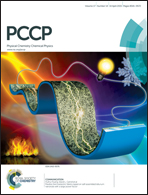Capacitance spectroscopy and density functional theory†
Abstract
The redox capacitance and its associated quantum component arising from the charging of molecular levels from coupled metallic states are resolvable and quantified experimentally by capacitance spectroscopy (CS). Herein we relate both this N-electron system capacitance directly to conceptual chemistry density functional theory (DFT) and the charging magnitude and associated quantum capacitive term (which resemble those introduced by Serge Luryi) to the Kohn–Sham frontier molecular orbital associated energies for isolated molecules and DFT calculated redox density of states (DOS) at metal–molecule junctions for a single molecule and molecular films confined at metallic interfaces. DFT computational analyses reveal the orbital energetic alignment between the iron redox site and those states in the metal specifically when metal–molecule junctions are formed. The impact of this on the resolved chemical softness and capacitance is also revealed. These analyses, additionally, are shown to numerically resolve redox capacitance in a manner that accurately reproduces experimental observations for molecular films. These observations both theoretically underpin CS and provide guidance on its optimised application in interfacial analyses involving molecular electrochemistry and derived sensory applications.


 Please wait while we load your content...
Please wait while we load your content...